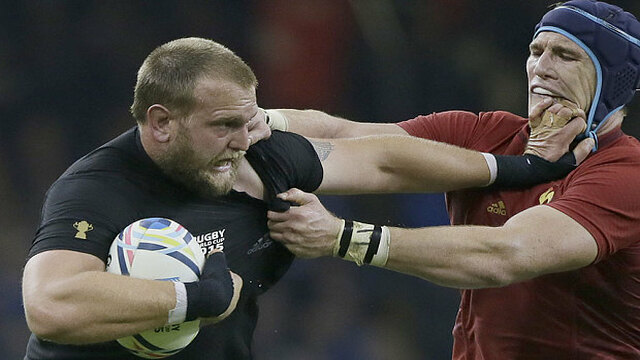Joe Moody scrum technique
New Zealand has been searching for the long-term replacement to their great loose-head prop Tony Woodcock, who won 118 caps for the All Blacks in a career spanning 13 years, and the coaches appear to have found their man in Joe Moody.
It is a revealing exercise to look at Moody’s technique in the light of the coaching modules produced by both Kees Meeuws and Carl Hoeft, two of Moody’s predecessors in the All Black #1 jersey.
Kees Meeuws breaks down the scrum into three distinct phases – the pre-engagement, the bind and post-engagement – while Carl Hoeft shows how the single man sled can be used to increase co-ordination in a ‘pod’ (loose-head prop, lock and flanker). I believe that this is a particularly important practice in the context of the modern-day professional scrum.
Both Meeuws and Hoeft emphasize that the outcome of a scrum can often be determined by the set-up before engagement, and there were some subtle differences in the pre-engagement set-up by Joe Moody in the course of the first half.
At the very beginning of the game, Moody has the ideal pre-engagement ‘look’ explained by Kees Meeuws – head up, straight back, chest punched out:

Towards the end of the half (at a scrum where New Zealand were rolled back off the ball), the set-up is slightly different:

The chest is a little more concave and the head hangs slightly lower – lower relative to his hooker Dane Coles than in the earlier snapshot. The backs of both Moody and the flanker behind him (Elliott Dixon) are slightly more curved in the second example, as if the All Black loose-head is sending out an unconscious ‘ripple effect’ via his body position to the forwards supporting him.
It is nonetheless still a shock to observe the radically different results of such small variations in the set-up position. When Moody sets up accurately, his head naturally shifts underneath the sternum of his opposite number Tomas Francis into his optimal ‘power position’ as the pressure comes on, and the scrum moves forward. Watch it here
At 11:03 Moody gets a nice extension through the hit which enables him to work his head inwards under the chest of Francis, and leaves the Welsh tight-head struggling to keep his shoulders level with the line of his hips.
At 11:07 Moody clearly has the lower, more comfortable position with the straighter back. It is at this point that the left side of the All Black scrum begins to play as an independent ‘pod’ – a nuance which might well have been practised on the single man sled advocated by Carl Hoeft. The angle changes, and Moody,
Dixon and the left lock Sam Whitelock all step out in order to be able to drive in at an angle – this is most evident in the snapshot at 11:10. There is a big gap between the backsides of the two All Black locks created by the change of angle over the left side.
When Moody’s set-up is inferior, the engagement is much worse and the outcome is a scrum disaster!
Here it is Francis who gets the better hit and extends through into the more comfortable low position at 31:03. The silhouette of Moody’s head is visible with his chin pushed down on his chest in the centre of the scrum. When the pressure comes on, his head is naturally pushed out to the side at 31:06 – which Kees Meeuws describes as one of the loose-head’s weakest positions in his module:

Francis has effectively split the All Blacks loose-head and hooker and promptly drives straight through the gap. This time it is Elliott Dixon who comes up off the side of the scrum before his opposite number, illustrating the lack of cohesion in the New Zealand set-piece.
Joe Moody got it right far more than he got it wrong in the match as a whole, and the following scrum was right at the top of his highlight reel:
The keys are the same – accurate set-up and the more comfortable low position at 20:03, the head movement into the sternum at 20:06, the left side shift by Moody, Whitelock and the loose-head flanker Sam Cane with ‘spines in line’ at 20:07; the cumulative pressure of the ‘right side straight’ and ‘left side inwards’ angles forcing Tomas Francis up and out through the roof of the scrum by its end:

Outcomes like this are no accident. They are the result of accurate repetitions on the one-man sled, in preparation for the engagement and for the correct processes in contact. Only perfect practice makes perfect on the field, as Bob Dwyer once said. Nowhere is this more true than in the dark world of the set-piece scrummage.


